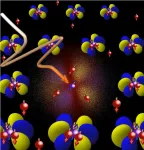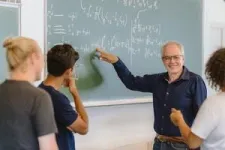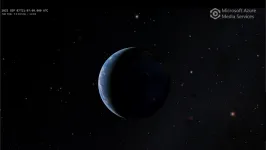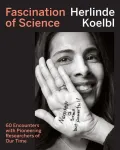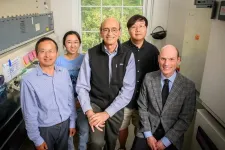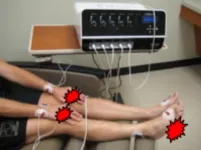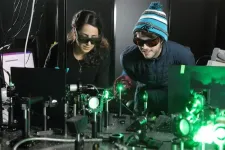(Press-News.org) Many substances change their properties when they are cooled below a certain critical temperature. Such a phase transition occurs, for example, when water freezes. However, in certain metals there are phase transitions that do not exist in the macrocosm. They arise because of the special laws of quantum mechanics that apply in the realm of nature’s smallest building blocks. It is thought that the concept of electrons as carriers of quantized electric charge no longer applies near these exotic phase transitions. Researchers at the University of Bonn and ETH Zurich have now found a way to prove this directly. Their findings allow new insights into the exotic world of quantum physics. The publication has now been released in the journal Nature Physics.
If you cool water below zero degrees Celsius, it solidifies into ice. In the process, it abruptly changes its properties. As ice, for example, it has a much lower density than in a liquid state - which is why icebergs float. In physics, this is referred to as a phase transition.
But there are also phase transitions in which characteristic features of a substance change gradually. If, for example, an iron magnet is heated up to 760 degrees Celsius, it loses its attraction to other pieces of metal - it is then no longer ferromagnetic, but paramagnetic. However, this does not happen abruptly, but continuously: The iron atoms behave like tiny magnets. At low temperatures, they are oriented parallel to each other. When heated, they fluctuate more and more around this rest position until they are completely randomly aligned, and the material loses its magnetism completely. So while the metal is being heated, it can be both somewhat ferromagnetic and somewhat paramagnetic.
Matter particles cannot be destroyed
The phase transition thus takes place gradually, so to speak, until finally all the iron is paramagnetic. Along the way, the transition slows down more and more. This behavior is characteristic of all continuous phase transitions. “We call it ‘critical slowing down,’“ explains Prof. Dr. Hans Kroha of the Bethe Center for Theoretical Physics at the University of Bonn. “The reason is that with continuous transitions, the two phases get energetically closer and closer together.” It is similar to placing a ball on a ramp: It then rolls downhill, but the smaller the difference in altitude, the more slowly it rolls. When iron is heated, the energy difference between the phases decreases more and more, in part because the magnetization disappears progressively during the transition.
Such a “slowing down” is typical for phase transitions based on the excitation of bosons. Bosons are particles that “generate” interactions (on which, for example, magnetism is based). Matter, on the other hand, is not made up of bosons but of fermions. Electrons, for example, belong to the fermions.
Phase transitions are based on the fact that particles (or also the phenomena triggered by them) disappear. This means that the magnetism in iron becomes smaller and smaller as fewer atoms are aligned in parallel. “Fermions, however, cannot be destroyed due to fundamental laws of nature and therefore cannot disappear,” Kroha explains. “That’s why normally they are never involved in phase transitions.”
Electrons turn into quasi-particles
Electrons can be bound in atoms; they then have a fixed place which they cannot leave. Some electrons in metals, on the other hand, are freely mobile - which is why these metals can also conduct electricity. In certain exotic quantum materials, both varieties of electrons can form a superposition state. This produces what are known as quasiparticles. They are, in a sense, immobile and mobile at the same timetime – a feature that is only possible in the quantum world. These quasiparticles - unlike “normal” electrons - can be destroyed during a phase transition. This means that the properties of a continuous phase transition can also be observed there, in particular, critical slowing down.
So far, this effect could be observed only indirectly in experiments. Researchers led by theoretical physicist Hans Kroha and Manfred Fiebig’s experimental group at ETH Zurich have now developed a new method, which allows direct identification of the collapse of quasiparticles at a phase transition, in particular the associated critical slowing down.
“This has enabled us to show for the first time directly that such a slowdown can also occur in fermions,” says Kroha, who is also a member of the Transdisciplinary Research Area “Matter” at the University of Bonn and the Cluster of Excellence “Matter and Light for Quantum Computing” of the German Research Foundation. The result contributes to a better understanding of phase transitions in the quantum world. On the long term, the findings might also be useful for applications in quantum information technology.
Participating institutions and funding:
The study was carried out in collaboration of ETH Zurich and the University of Bonn. The work was funded by the Swiss National Science Foundation (SNF) and the German Research Foundation (DFG).
Publication: Chia-Jung Yang, Kristin Kliemt, Cornelius Krellner, Johann Kroha, Manfred Fiebig and Shovon Pal: Critical slowing down near a magnetic quantum phase transition with fermionic breakdown. Nature Physics, DOI: 10.1038/s41567-023-02156-7; Internet: https://www.nature.com/articles/s41567-023-02156-7
Media contact:
Prof. Dr. Hans Kroha
Institute of Physics and
Bethe Center for Theoretical Physics
University of Bonn
Tel. +49 228 735960
E-mail: jkroha@uni-bonn.de
END
When electrons slowly vanish during cooling
Researchers observe an effect in the quantum world that does not exist in the macrocosm
2023-07-31
ELSE PRESS RELEASES FROM THIS DATE:
BU commentary: Including sexual and gender minority populations in medical research guarantees the health and well-being of all
2023-07-31
(Boston)—In the face of ongoing political threats to the rights and well-being of sexual and gender minority (SGM) populations, public health and health care institutions and practitioners must explicitly address the needs of marginalized populations while ensuring that those with multiple marginalized identities are well represented in research, according to a commentary in JAMA Network Open.
“If we continue to exclude SGM in research, we will remain oblivious to the troubles they face in achieving health and well-being,” said lead author Carl G. Streed, Jr., MD, MPH, FACP, ...
Luzio, who lived in São Paulo 10,000 years ago, was Amerindian like Indigenous people now, DNA reveals
2023-07-31
An article to be published on July 31 in Nature Ecology & Evolution reveals that Luzio, the oldest human skeleton found in São Paulo state (Brazil), was a descendant of the ancestral population that settled the Americas at least 16,000 years ago and gave rise to all present-day Indigenous peoples, such as the Tupi.
Based on the largest set of Brazilian archeological genomic data, the study reported in the article also offers an explanation for the disappearance of the oldest coastal communities, who built the icons of Brazilian archeology known as sambaquis, huge mounds of shells and fishbones used as dwellings, cemeteries and territorial boundaries. Archeologists often ...
Bees evolved from ancient supercontinent, diversified faster than suspected
2023-07-31
The first bees evolved on an ancient supercontinent more than 120 million years ago, diversifying faster and spreading wider than previously suspected, a new study shows.
Led by Washington State University researchers, the study provides a new best estimate for when and where bees first evolved. Newly published in the journal Current Biology, the project reconstructed the evolutionary history of bees, estimated their antiquity, and identified their likely geographical expansion around the world.
The results indicate their point of origin was in western Gondwana, an ancient supercontinent that at that time included today's continents of Africa and South America.
“There’s ...
New algorithm ensnares its first ‘potentially hazardous’ asteroid
2023-07-31
Link to Google Drive folder containing images, videos and caption/credit information:
https://drive.google.com/drive/folders/19LP7UZbVKkTXSFds6DaKSy1lp014Hw4z?usp=sharing
Link to release:
https://www.washington.edu/news/2023/07/31/heliolinc3d/
FROM: James Urton
University of Washington
+1 206-543-2580
jurton@uw.edu
Ranpal Gill
Vera C. Rubin Observatory
+1 520-309-6195
rgill@lsst.org
Note: Researcher contact information at the end
For ...
Fascination of Science: 60 Encounters with Pioneering Researchers of Our Time
2023-07-31
What makes a brilliant scientist? Who are the people behind the greatest discoveries of our time? Connecting art and science, photographer Herlinde Koelbl seeks the answers in this English translation of the German book Fascination of Science, an indelible collection of portraits of and interviews with sixty pioneering scientists of the twenty-first century. Koelbl's approach is intimate and accessible, and her highly personal interviews with her subjects reveal the forces (as well as the personal quirks) that motivate the scientists' work; for example, one wakes up at 3 am because ...
Team identifies key driver of cancer cell death pathway that activates immune cells
2023-07-31
CHAMPAIGN, Ill. — Scientists have identified a protein that plays a pivotal role in the action of several emerging cancer therapies. The researchers say the discovery will likely aid efforts to fine-tune the use of immunotherapies against several challenging cancers. They report their findings in the journal Cancer Research.
“Most anticancer drugs cause cancer cells to shrivel up and die in a controlled process known as apoptosis. But apoptosis does not usually strongly activate immune cells,” said David Shapiro, a professor ...
Scrambler therapy may offer lasting relief for chronic pain, review paper suggests
2023-07-31
FOR IMMEDIATE RELEASE
A new review paper co-authored by two Johns Hopkins pain experts suggests that scrambler therapy, a noninvasive pain treatment, can yield significant relief for approximately 80%–90% of patients with chronic pain, and it may be more effective than another noninvasive therapy: transcutaneous electrical nerve stimulation (TENS). The write-up was published online July 13 in The New England Journal of Medicine.
Scrambler therapy, approved by the U.S. Food and Drug Administration in 2009, administers electrical stimulation through the skin via electrodes placed in areas of the body above and below where chronic pain is felt. The goal is to capture the nerve endings ...
Icahn School of Medicine at Mount Sinai receives $11.5 million grant renewal to study the impact of psychosocial stress on cardiovascular disease
2023-07-31
New York, NY (July 31, 2023)—Psychosocial stress profoundly affects people’s lives globally, not least because it can be a critical risk factor for cardiovascular disease. Thanks to an $11.5 million award renewal from the National Heart, Lung, and Blood Institute (NHLBI) of the National Institutes of Health, distinguished researchers at the Icahn School of Medicine at Mount Sinai and elsewhere aim to gain a deeper understanding of how stress influences cardiovascular health.
“To address residual cardiovascular risk in patients, our research program aims to bolster our mechanistic understanding ...
Way cool: UVA professor developing ‘freeze ray’ technology for the Air Force
2023-07-31
You know that freeze-ray gun that “Batman” villain Mr. Freeze uses to “ice” his enemies? A University of Virginia professor thinks he may have figured out how to make one in real life.
The discovery – which, unexpectedly, relies on heat-generating plasma – is not meant for weaponry, however. Mechanical and aerospace engineering professor Patrick Hopkins wants to create on-demand surface cooling for electronics inside spacecraft and high-altitude jets.
“That’s the primary problem right now,” Hopkins said. “A lot of electronics on board heat up, but they have no way to cool down.”
The U.S. Air Force likes the prospect of a freeze ...
Bees likely evolved from ancient supercontinent, earlier than suspected
2023-07-31
PULLMAN, Wash. –The origin of bees is tens of millions of years older than most previous estimates, a new study shows.
A team led by Washington State University researchers traced the bee genealogy back more than 120 million years to an ancient supercontinent, Gondwana, which included today’s continents of Africa and South America.
In a study that proposes a new evolutionary history of bees, the researchers found evidence that bees originated earlier, diversified faster and spread wider than many scientists previously suspected. They published their findings in the journal Current ...
LAST 30 PRESS RELEASES:
Numbers in our sights affect how we perceive space
SIMJ announces global collaborative book project in commemoration of its 75th anniversary
Air pollution exposure and birth weight
Obstructive sleep apnea risk and mental health conditions among older adults
How talking slows eye movements behind the wheel
The Ceramic Society of Japan’s Oxoate Ceramics Research Association launches new international book project
Heart-brain connection: international study reveals the role of the vagus nerve in keeping the heart young
Researchers identify Rb1 as a predictive biomarker for a new therapeutic strategy in some breast cancers
Survey reveals ethical gaps slowing AI adoption in pediatric surgery
Stimulant ADHD medications work differently than thought
AI overestimates how smart people are, according to HSE economists
HSE researchers create genome-wide map of quadruplexes
Scientists boost cell "powerhouses" to burn more calories
Automatic label checking: The missing step in making reliable medical AI
Low daily alcohol intake linked to 50% heightened mouth cancer risk in India
American Meteorological Society announces Rick Spinrad as 2026 President-Elect
Biomass-based carbon capture spotlighted in newly released global climate webinar recording
Illuminating invisible nano pollutants: advanced bioimaging tracks the full journey of emerging nanoscale contaminants in living systems
How does age affect recovery from spinal cord injury?
Novel AI tool offers prognosis for patients with head and neck cancer
Fathers’ microplastic exposure tied to their children’s metabolic problems
Research validates laboratory model for studying high-grade serous ovarian cancer
SIR 2026 delivers transformative breakthroughs in minimally invasive medicine to improve patient care
Stem Cell Reports most downloaded papers of 2025 highlight the breadth and impact of stem cell research
Oxford-led study estimates NHS spends around 3% of its primary and secondary care budget on the health impacts of heat and cold in England
A researcher’s long quest leads to a smart composite breakthrough
Urban wild bees act as “microbial sensors” of city health.
New study finds where you live affects recovery after a hip fracture
Forecasting the impact of fully automated vehicle adoption on US road traffic injuries
Alcohol-related hospitalizations from 2016 to 2022
[Press-News.org] When electrons slowly vanish during coolingResearchers observe an effect in the quantum world that does not exist in the macrocosm
